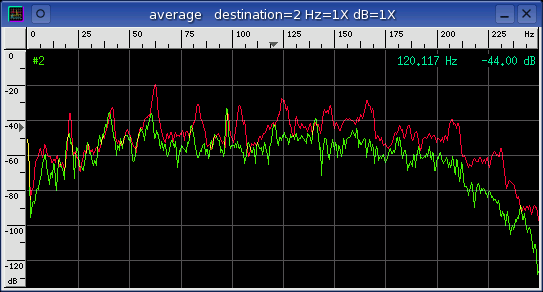We've got signal, but what the heck is it?
That's your mission. Analyze this bébé.

 download the audio file 5.wav.gz
download the audio file 5.wav.gz
hints :
-
Setup baudline to be a Netscape helper application as described
in the FAQ.
-
Turn on the 60 Hz notch filter in the play deck.
-
Try playing the mystery signal at different speeds, slow
it down or drop it an octave.
-
Use baudline's
harmonic helper bars and
delta measurement bars
to determine the harmonic relationships.
What is it?
This mystery signal may sound like a very large and very
angry bumble bee, but it's not. Slow it down to a quarter speed and
you will hear the true infernal racket of dual pneumatic jack hammers.
I had the pleasure of having the driveway just outside my window smashed
into little pieces by these incredibly loud tools of destruction.
So in standard SigBlips fashion let's analyze the components and break
this signal down (heh heh pun intended).
The steady state 50 Hz fundamental with an even stronger
2nd harmonic at 100 Hz is the large gas powered air compressor that powers
the jack hammers. Notice how the tone wavers several Hz up and down
as the jack hammer load changes.
The pulsed jack hammer bursts have a fundamental of around
20 Hz with strong harmonics all the way up to and past the Nyquist rate
of 250 Hz. Considering that concrete is being violently crushed, one would
expect loud broad band noise, but instead the sound is a rather pure
tone with strong harmonic content, very much like a human voice
making the "mmmmm" sound.
Finding evidence for the existence of two jack hammers
is not obvious. One jack hammer was much closer to the microphone
making it about 16 dB louder thus masking the quieter one.
The short in duration and lower amplitude blips at the 43.5 and 48
second marks have a very different harmonic signature (see average spectrum
display below). The burst from 20 to 25 seconds is interesting in
that you can see both jack hammers at work at the same time.

|
![]()